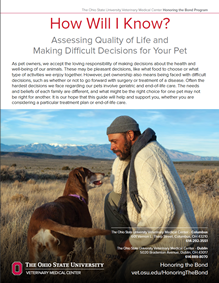Helpful Quality of Life Information
Many of Heaven At Home’s clients have found assistance and comfort by using the resources and assessment tools of Ohio State University’s “Honoring the Bond” program. “How Will I Know” addresses making difficult medical treatment decisions, dispels many euthanasia myths, and offers a comprehensive assessment questionnaire, together with anticipatory grief advice for pet parents, companion animals, and children.
In addition, our team finds this short “Quality of Life” Scorecard below helpful for our clients.
Contact us if you’d like assistance in your assessment, or feel ready to plan a peaceful and compassionate end to your fur friend’s life story.
Knowing when to say goodbye is hard, but with the right support, advice, and planning, it can be a beautiful final gift to give your beloved pet for his or her years of loyal companionship.
|
Score
|
Criterion
|
|---|---|
|
1 – 10
|
HURT – First and foremost on the scale: Is pain control adequate? This includes breathing ability. Is the pet’s pain successfully managed? Are extra measures like oxygen necessary? |
|
1 – 10
|
HUNGER – Is the pet eating enough and getting proper nutrition? Is hand-feeding necessary? Does the patient require a feeding tube? |
|
1 – 10
|
HYDRATION – Is the patient appropriately hydrated? Can they drink enough on their own, or do they require supplementation via subcutaneous or intravenous fluids? |
|
1 – 10
|
HYGIENE – Can the patient keep themselves clean? Does it require assistance? (Patients should be brushed and cleaned, particularly after elimination. Appropriate bedding to avoid pressure sores, keep any wounds clean/dressed, etc). |
|
1 – 10
|
HAPPINESS – Does the pet express joy and interest? Is the pet responsive and interactive to things around him or her (family, toys, etc.)? Is the pet depressed, lonely, anxious, bored or afraid? Can the pet’s hospice area or bed be close to the family activities and not be isolated? |
|
1 – 10
|
MOBILITY – Can the patient get up and about? Does the pet need human or mechanical assistance (e.g., a cart)? Does the pet feel like going for a walk? Is the pet having seizures or stumbling? |
|
1 – 10
|
MORE GOOD DAYS THAN BAD – Do the good hours or days outnumber the bad ones? When bad days outnumber good days, quality of life might be compromised. When a healthy human-animal bond is no longer possible, the caregiver must be made aware the end is near. The decision needs to be made if the pet is suffering. If death comes peacefully and painlessly, that is okay. |
|
*TOTAL
|
*A total over 35 points generally represents acceptable life quality |
Adapted from Villalobos, A.E., Quality of Life Scale Helps Make Final Call, VPN, 09/2004, for Canine and Feline Geriatric Oncology Honoring the Human-Animal Bond, by Blackwell Publishing, Table 10.1, released 2006.

